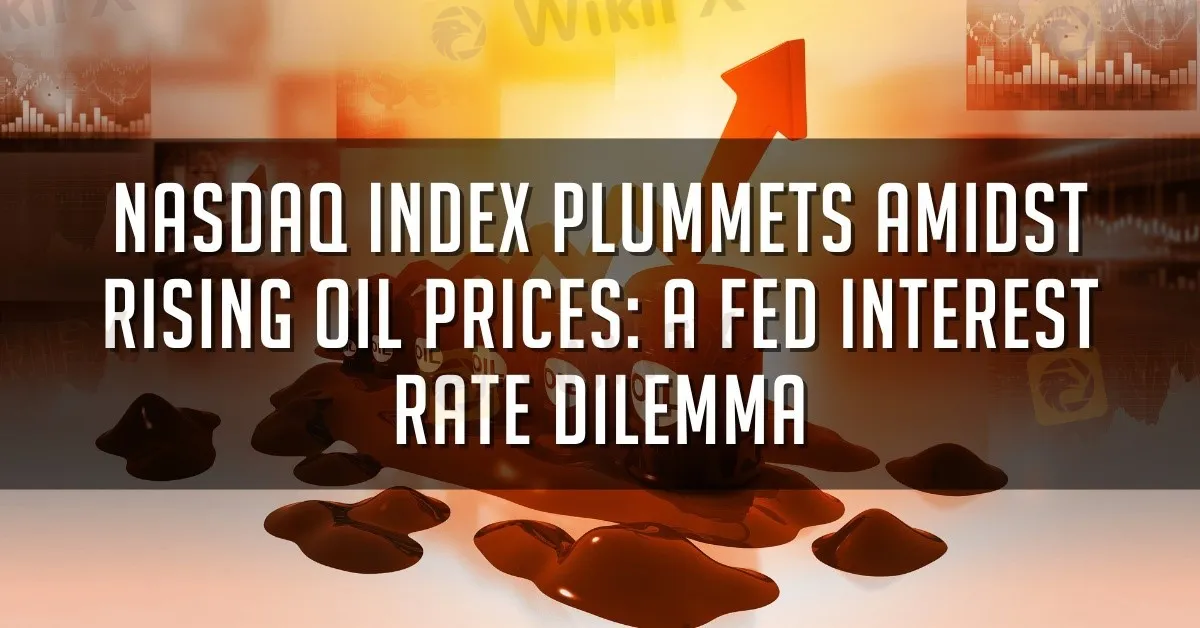Nasdaq Index Plummets Amidst Rising Oil Prices: A Fed Interest Rate Dilemma
Abstract:In an unstable market environment, the Nasdaq index experienced a severe devaluation, highlighting the correlation between the Federal Reserve's interest rate policies and escalating oil prices.

In an unstable market environment, the Nasdaq index experienced a severe devaluation, highlighting the correlation between the Federal Reserve's interest rate policies and escalating oil prices. There has been a noticeable change in the tone of ongoing conversations concerning the Federal Reserve's financial strategy. The emphasis is now more balanced, due to encouraging inflation figures and a steady job market.
Federal Reserve officials have displayed remarkable consistency and elevated interest rates in 11 of their last 12 meetings. In their most recent move in July, they pushed the range from 5.25% to 5.5%, marking a 22-year high. As the eagerly anticipated Fed meeting in September approaches, indications are that they may opt to maintain their current interest rates, affording them valuable time to assess the economy's response to the previous rate hikes.
The current debate revolves around the triggers that could prompt the Fed to consider raising rates again, potentially in November or December. In June, the consensus among most officials pointed to the necessity of a further quarter-point increase within the year. After the September meeting, projections might hint at another rate hike, but the ultimate decision remains uncertain.
However, the current focal point is the spiralling oil prices. The previous week saw oil prices surging to their peak levels for the year, with aspirations of breaching the coveted $100-per-barrel milestone before the year's end. Some analysts even postulate this milestone could be achieved sooner than expected.
Brent and WTI crude oil prices attained their highest points this year during the past week, marking a substantial ascent. Furthermore, these oil contracts have notched their third straight positive week amid ongoing concerns about supply constraints.
The recent rally in oil prices can be primarily attributed to strategic moves by Saudi Arabia and Russia aimed at depleting global oil inventories and extending their cuts in oil production until year-end. Saudi Arabia, the influential leader within OPEC, declared on September 5th its intention to continue its 1 million barrel per day production cut until the end of the year. Simultaneously, Russia, a crucial non-OPEC player, pledged to curtail oil exports by 300,000 barrels per day during the same period. Both nations have expressed their readiness to review these voluntary production cuts monthly.
It is imperative to recognise that oil prices wield substantial influence in determining inflationary pressures, given their impact on diverse sectors of the economy. As oil prices ascend, businesses across various industries contend with increased production and transportation expenses. This invariably translates to higher input costs, which may ultimately be passed on to consumers through elevated prices for goods and services. Furthermore, the surge in oil prices can reverberate through global supply chains, imposing cost pressures at various stages and potentially inflating prices for imported goods.
Considering these conditions, it's natural to wonder: Is there certainty that the Federal Reserve will conclusively end its ongoing rate increase cycle? A convergence of elements, such as the rise in oil prices, guarantees that the future of monetary policy is loaded with intricacies and unpredictabilities.

Read more

Voices of the Golden Insight Award Jury | George Georgiou, the Co-Founder of Dynamic Works
WikiFX Golden Insight Award uniting industry forces to build a safe and healthy forex ecosystem, driving industry innovation and sustainable development, launches a new feature series — “Voices of the Golden Insight Awards Jury.” Through in-depth conversations with distinguished judges, this series explores the evolving landscape of the forex industry and the shared mission to promote innovation, ethics, and sustainability.

Prop Firm Tradeify Signs ‘The Nuke’ as Global Brand Ambassador
Miami-based prop trading firm Tradeify has officially announced a major long-term partnership with Luke “The Nuke” Littler, the current World Number 1 and reigning 2024/2025 PDC Darts World Champion. Littler joins Tradeify as its new Global Brand Ambassador, marking one of the company’s most significant branding investments to date.

Close Up With WikiFX —— Take A Close Look At Amillex
With the rapid growth of global multi-asset investment markets, the differences among regional forex markets have become increasingly significant. As a forex broker information service platform operating in more than 180 countries and regions, WikiFX is dedicated to helping investors in every market identify reliable brokers. Therefore, we have launched an exclusive interview series —— "Close Up With WikiFX", offering in-depth conversations with local brokers. This series aims to dive deep into frontline markets and provide first-hand information, helping investors gain a clearer and more comprehensive understanding of quality brokers.

Polymarket Onboards First US Users Since 2022 Shutdown: Beta Relaunch Signals Major Comeback
Crypto-based prediction platform Polymarket has officially begun onboarding select U.S. users for real-money betting, marking its first return to the American market since a regulatory shutdown in 2022.
WikiFX Broker
Latest News
Simulated Trading Competition Experience Sharing
WinproFx Regulation: A Complete Guide to Its Licensing and Safety for Traders
Interactive Brokers Expands Access to Taipei Exchange
Axi Review: A Data-Driven Analysis for Experienced Traders
INZO Regulation and Risk Assessment: A Data-Driven Analysis for Traders
Cleveland Fed's Hammack supports keeping rates around current 'barely restrictive' level
Delayed September report shows U.S. added 119,000 jobs, more than expected; unemployment rate at 4.4%
The CMIA Capital Partners Scam That Cost a Remisier Almost Half a Million
eToro Cash ISA Launch Shakes UK Savings Market
Is Seaprimecapitals Regulated? A Complete Look at Its Safety and How It Works
Rate Calc


